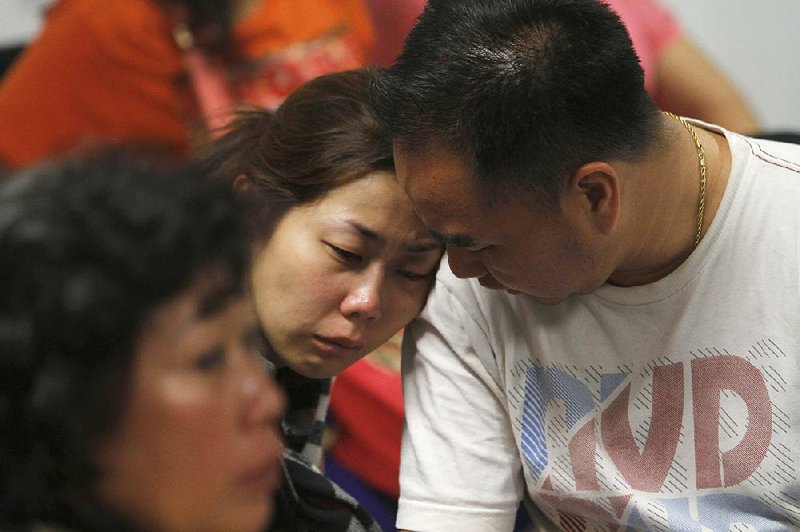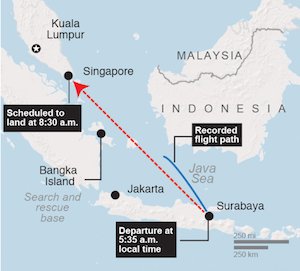JAKARTA, Indonesia -- A search-and-rescue operation resumed today in the Java Sea for a commercial airliner with 162 people on board that lost contact with ground controllers off the coast of Borneo, an effort that evoked a familiar mix of grief and mystery nine months after a Malaysia Airlines jetliner disappeared over the Indian Ocean.
This plane, too, had Malaysian connections: The Airbus A320-200 was operated by the Indonesian affiliate of AirAsia, a regional low-fare carrier based in Malaysia.
Indonesian authorities could not explain Sunday why the AirAsia jet disappeared from radar screens about 40 minutes after leaving the Indonesian city of Surabaya around 5:30 a.m.
By nightfall, more than 12 hours later, searchers facing bad weather had found no sign of the wreckage, and the search was called off for the night, Indonesian officials said.
Indonesian 1st Adm. Sigit Setiayana, the Naval Aviation Center commander at the Surabaya air force base, said 12 navy ships, five planes, three helicopters and a number of warships were taking part, along with ships and planes from Singapore and Malaysia. The Australian air force also sent a search plane.
Setiayana said visibility was good. "God willing, we can find it soon," he said.
A rescue official said today that given the route of the plane, he believed the most likely scenario was that it crashed.
"Based on the coordinates that we know, the evaluation would be that any estimated crash position is in the sea, and that the hypothesis is the plane is at the bottom of the sea," National Search and Rescue chief Henry Bambang Soelistyo said during a news conference.
The weather along the path of Flight QZ8501 to Singapore was cloudy, and a United States-based weather monitoring service reported a number of lightning strikes along the way. But the monsoon conditions did not seem insurmountable for a modern airliner.
The route was a well-traveled part of the Indonesian archipelago; six other aircraft were in the vicinity of Flight QZ8501 when it disappeared, according to data by Flightradar24, an organization that tracks aircraft.
The search is along a 100-mile stretch of the Java Sea near the island of Belitung, between the islands of Borneo and Sumatra, the plane's last known location.
Shortly before contact was lost Sunday, the cockpit crew informed air traffic controllers in Jakarta that they were planning to rise to 38,000 from 32,000 feet to avoid a cloud, Djoko Murjatmodjo, the acting director general of Air Transport at Indonesia's Ministry of Transportation, told reporters at a news conference in Jakarta.
"At the moment, we don't know where the exact location is, except that this morning at 6:17, we lost contact," Murjatmodjo said. The Singapore authorities said contact was lost at 6:24 a.m. Jakarta time. The discrepancy has not been explained.
Murjatmodjo said the authorities had not detected any emergency distress beacons that are normally triggered by an accident.
Kompas newspaper in Indonesia quoted Murjatmodjo as saying that the plane's request to divert from its flight path was approved but that air traffic controllers denied the request to ascend to 38,000 feet "because of traffic."
The paper also quoted Syamsul Huda, director for aviation and meteorology at the Indonesian state weather agency, as saying that there were "many clouds along the route."
Earth Networks, a company that tracks weather conditions across the globe, said it had recorded a number of lightning strikes "near the path" of Flight 8501 on Sunday morning between 6:09 and 6:20.
While it is rare for a lightning strike to cause serious structural damage, it can disrupt navigation systems, such as magnetic compasses. A lightning flash, particularly at night, can also momentarily disorient the pilots.
The turbulence associated with a big storm can sometimes be severe and sudden shifts in wind direction could disrupt the airflow through a jet engine, potentially causing it to shut down. A shutdown of all engines in such a scenario would be highly unlikely and the Airbus A320 is certified to fly up to three hours on a single engine, in compliance with global aviation safety regulations.
AirAsia group CEO Tony Fernandes flew to Surabaya and said during a news conference that the focus for now should be on the search and the families rather than the cause of the incident.
"We have no idea at the moment what went wrong," said Fernandes, a Malaysian businessman who founded the low-fare carrier in 2001. "Let's not speculate at the moment."
At the Surabaya airport, passengers' relatives pored over the plane's manifest, crying and embracing. Nias Adityas, a housewife from Surabaya, was overcome with grief when she found the name of her husband, Nanang Priowidodo, on the list.
The tour agent, 43, had been taking a family of four on a trip to Singapore, Malaysia and Indonesia's Lombok Island, and had been happy to get the work.
"He just told me, 'Praise God, this new year brings a lot of good fortune,'" Adityas said.
At Singapore's Changi Airport, a holding area was been set up for relatives and friends of the passengers.
Louise Sidharta, 25, said her fiance, Alain, a 27-year-old entrepreneur, was traveling with his parents and three brothers.
"We had planned to marry in May next year," Sidharta said. "We are not thinking negatively right now. We are only having positive thoughts."
Relatives and friends who had earlier registered at the holding area have left for the night, Changi Airport said. Sixteen have taken up an offer to fly to Surabaya tonight, while the rest have gone home or to a hotel, it said
AirAsia said in its statement that the passengers included 16 children and one infant. A crew of two pilots and five cabin crew members were also on board.
The passengers and crew consist of 155 Indonesians, three South Koreans, one Singaporean, one Malaysian, one Briton and a French citizen, AirAsia said.
The captain was identified as Irianto, who, like many Indonesians, uses only one name. France's Foreign Ministry said the French citizen was the co-pilot.
AirAsia said the captain had more than 20,000 flying hours, of which 6,100 were with AirAsia on the Airbus 320. The first officer had 2,275 flying hours.
The missing aircraft was delivered to AirAsia in October 2008, and the plane had accumulated about 23,000 flight hours during some 13,600 flights, Airbus said in a statement.
The aircraft had last undergone scheduled maintenance Nov. 16, according to AirAsia.
Four airline tragedies in which more than 600 people died made 2014 one of the worst years for Asian aviation even before the disappearance of QZ8501.
The unresolved disappearance of Malaysia Airlines flight MH370 over the Indian Ocean, the downing of Malaysia Airlines flight MH17 over eastern Ukraine, the crash of a TransAsia Airways Corp. plane as it prepared to land on Taiwan's Penghu Islands and an August crash in Iran have marked a tragic year for Asia's booming aviation industry.
This year may end up being the worst for passenger fatalities globally since 2005, when 916 lives were lost, according to air-safety consultants Ascend Worldwide.
"It has affected many Asian airlines," said Shukor Yusof, founder of aviation research firm Endau Analystics. "The danger is that Malaysia has been seen as a country that produces unsafe airlines, which is not the case at all. It's just unfortunate that three aircraft have been lost and they all belong to Malaysian carriers. I don't think it's a reflection of those airlines' safety."
Since 2007, the European Union has barred dozens of carriers from Indonesia from its skies, in an effort to pressure local regulators to shore up air safety standards. The majority of airlines that appear on the European Union's so-called aviation blacklist -- which includes airlines from several African countries -- do not operate flights to Europe. However, travel agencies across the 28-member bloc are required to inform all European passengers who have plans to travel on a carrier listed on the aviation blacklist.
AirAsia, one of the world's fastest-growing airlines, has an excellent safety record. Its Indonesian subsidiary is not included on the European safety list, which was most recently updated this month. A budget long-haul affiliate, Indonesia AirAsia X, is among the airlines listed.
American officials said Sunday that no assistance had yet been requested by the Malaysian government or any of the other authorities conducting the search, but that the United States stood ready to help.
Eric Schultz, a White House spokesman, said President Barack Obama, who is vacationing in Hawaii, had been briefed on the search for the plane, and that "White House officials will continue to monitor the situation."
In the hours after the plane was reported missing, American law enforcement agents and intelligence analysts began combing through recent collections of phone intercepts, Internet postings and other communications but found no indications of a terrorist threat or other foul play, officials said.
On Sunday, Malaysia Airlines posted a message on its Twitter account: "#staystrong AirAsia -- Our thoughts and prayers are with all family and friends of those onboard QZ8501."
Information for this article was contributed by Thomas Fuller, Jeffrey Hutton, Nicola Clark, Poypiti Amatatham, Muktita Suhartono, Michael S. Schmidt and Eric Schmitt of The New York Times; by Trisnadi Marjan, Margie Mason, Ali Kotarumalo, Joan Lowy, Scott Mayerowitz and Lori Hinnant of The Associated Press; and by Deena Kamel Yousef, Kyunghee Park and Sharon Chen of Bloomberg News.
A Section on 12/29/2014

